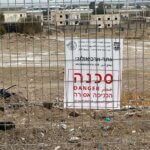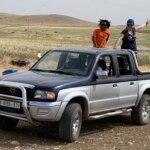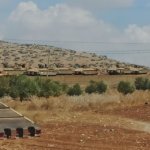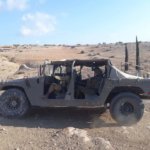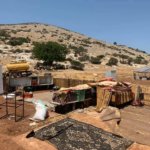Mondoweiss: Living under fire
Published by Mondoweiss 17th November 2017
By Yumna Patel and Akram Al-Wa’ra
It was an ordinary summer day for the Nawaja’a family in the quiet village of Ibziq, a small Bedouin community located in the northern Jordan Valley area of the occupied West Bank.
At around 7 a.m. 16-year-old Uday and his brother Diaa, 18, set off into the mountains surrounding their village to graze their flocks, as they did every day. Three hours later, they returned to eat breakfast and give their goats water.
At 2 p.m, the brothers set out again, this time with their uncle Da’as.
“I was tending to the flock, as Uday was wandering underneath a tree, about 30 meters away,” Diaa told Mondoweiss. “Suddenly, I heard an explosion.”
“I ran over to Uday to see what happened. But a few seconds later, he was dead.”
Uday had stumbled upon an unexploded ordnance, left behind by the Israeli army, which conducts weekly training exercises in Ibziq and the surrounding areas.
Ibziq is one of dozens of villages in the Jordan Valley that Israel has designated as an active military “firing zone.”
Rashid Khdeir, a local activist, told Mondoweiss that around 56% of the land in the Jordan Valley has been declared firing zones by the army.
“The army uses these areas to train using live ammunition and explosive devices,” Khdeir said, adding that Palestinians in these firing zones are routinely forced out of their homes for the duration of the army’s training activities, sometimes for days at a time.

Uday’s story, while sudden and tragic for his family, is not an uncommon occurrence in the Jordan Valley.
Khdeir, along with many locals, told Mondoweiss stories similar to Uday’s, in which locals either lost their lives or their limbs. With more than half of its land used as active military training zones, the Jordan Valley is littered with unexploded ordnances.
According to Palestinian NGO the Applied Research Institute – Jerusalem (ARIJ), more than 400,000 dunams (98,842 acres) of the 720,000 dunams (177,916 acres) that make up the total area of the Jordan Valley has been transformed into closed military and firing zones, with at least 27,000 dunams (6,672 acres) confiscated for illegal Israeli settlement building.
Palestinians in the Jordan Valley are one of the most vulnerable groups to displacement, with over 60 percent of the estimated 6,000 Palestinians forcibly displaced since 2008 belonged to herding or Bedouin communities, according to a 2016 report from the Office for the Coordination of Humanitarian Affairs (OCHA).
Israeli nonprofit Kerem Navot in a 2015 report showed that more than 1.8 million dunams of land (436,141 acres), almost one-third of the entire area of the West Bank, and more than half of Area C — the more than 60 percent of the West Bank under full Israeli control — have been declared closed military areas.
However, the group found that 78 percent of the total area declared as closed military or firing zones in the West Bank were not actually being used for military trainings, leading rights groups to conclude the firing zones are being used as a pretext to fully annex portions of the occupied West Bank.
In the South Hebron Hills, Palestinian communities living in closed military zones are at constant risk of displacement, and have been subject to years of demolitions by Israeli forces.
The village of Halaweh, located at the end of the southern West Bank just along the Green Line, is one of 12 villages in ‘Firing Zone 918’ that have been waging a legal battle for 17 years in an attempt to prevent their evacuation and demolition so their land can be used as Israeli army training areas.
Firing Zone 918, which encompasses approximately 30,000 dunams, was declared a restricted military zone as far back as the 1970s.
Khalil Younis, a local activist and resident of Halaweh, is one of 80 Palestinians, 25 of whom are children, residing in the village. In addition to suffering the loss of his home to demolitions over the years, Younis suffered the loss of his son in 2005 to an unexploded ordnance.
For decades, the Israeli army used the area only intermittently for training exercises, instead using the closed military zone designation as a way to demolish homes and prevent the shepherding communities from constructing anything from a well to a tent, according to Younis.
B’Tselem reported that in May 2012, for the first time in years, the Israeli army conducted live-fire exercises in the restricted area and erected concrete slabs along the area’s perimeter warning against entering “a firing zone.”
The group added that Israeli soldiers who served in the area gave testimony to the Breaking the Silence organization that in recent years the military had conducted no live-fire training exercises in the restricted area and had held only driver-training exercises with armored vehicles.
“They only use this (firing zone) as an excuse to kick us off our land,” Younis told Mondoweiss, adding that “they (army) only started training here recently to frustrate us so we will leave.”
“The life here is so hard, but we have no other choice but to stay on our land,” Younis said, “we will never leave our homes until we die, or until they kill us.”

